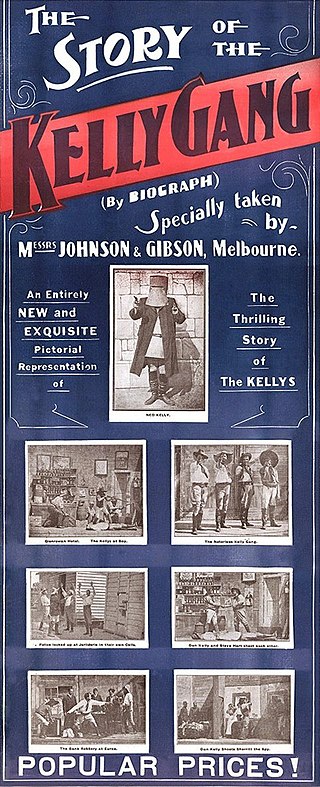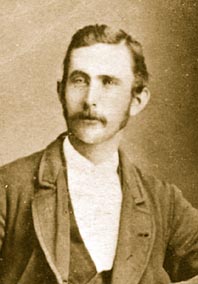Related Research Articles

The Story of the Kelly Gang is a 1906 Australian Bushranger film directed by Charles Tait. It traces the exploits of 19th-century bushranger and outlaw Ned Kelly and his gang, with the film being shot in and around Melbourne. The original cut of this silent film ran for more than an hour with a reel length of about 1,200 metres (4,000 ft), making it the longest narrative film yet seen in the world. It premiered at Melbourne's Athenaeum Hall on 26 December 1906 and was first shown in the United Kingdom in January 1908. A commercial and critical success, it is regarded as the origin point of the bushranging drama, a genre that dominated the early years of Australian film production. Since its release, many other films have been made about the Kelly legend.

Edward Kelly was an Australian bushranger, outlaw, gang leader and convicted police-murderer. One of the last bushrangers, he is known for wearing a suit of bulletproof armour during his final shootout with the police.

Sir Redmond Barry,, was a colonial judge in Victoria, Australia of Anglo-Irish origins. Barry was the inaugural Chancellor of the University of Melbourne, serving from 1853 until his death in 1880. He is arguably best known for having sentenced Ned Kelly to death.

True History of the Kelly Gang is a novel by Australian writer Peter Carey, based loosely on the history of the Kelly Gang. It was first published in Brisbane by the University of Queensland Press in 2000. It won the 2001 Booker Prize and the Commonwealth Writers Prize in the same year. Despite its title, the book is fiction and a variation on the Ned Kelly story.

The Old Melbourne Gaol is a former jail and current museum on Russell Street, in Melbourne, Victoria, Australia. It consists of a bluestone building and courtyard, and is located next to the old City Police Watch House and City Courts buildings, and opposite the Russell Street Police Headquarters. It was first constructed starting in 1839, and during its operation as a prison between 1845 and 1924, it held and executed some of Australia's most notorious criminals, including bushranger Ned Kelly and serial killer Frederick Bailey Deeming. In total, 133 people were executed by hanging. Though it was used briefly during World War II, it formally ceased operating as a prison in 1924; with parts of the jail being incorporated into the RMIT University, and the rest becoming a museum.

Ned Kelly is a 2003 Australian-British bushranger film based on Robert Drewe's 1991 novel Our Sunshine. Directed by Gregor Jordan, the film's adapted screenplay was written by John Michael McDonagh. The film dramatises the life of Ned Kelly, a legendary bushranger and outlaw who was active mostly in the colony of Victoria. In the film, Kelly, his brother Dan, and two other associates—Steve Hart and Joe Byrne—form a gang of bushrangers in response to acts of police brutality. Heath Ledger stars in the title role, with Orlando Bloom, Naomi Watts and Geoffrey Rush. The film received mixed reviews from critics and grossed $6 million worldwide.

Joseph Byrne was an Australian bushranger of Irish descent. A friend of Ned Kelly, he was a member of the "Kelly Gang" who were declared outlaws after the murder of three policemen at Stringybark Creek. Despite wearing the improvised body armour for which Ned Kelly and his gang are now famous, Byrne received a fatal gunshot during the gang's final violent confrontation with police at Glenrowan, in June 1880.

Glenrowan is a town located in the Wangaratta local government area of Victoria, Australia. It is 236 kilometres north-east of Melbourne and 14 kilometres from Wangaratta and near the Warby Ranges and Mount Glenrowan. At the 2021 census, Glenrowan had a population of 1,049.

Beechworth is a well-preserved historical town located in the north-east of Victoria, Australia, famous for its major growth during the gold rush days of the mid-1850s. At the 2021 census, Beechworth had a population of 3,290.

Catherine Ada Kelly was the younger sister of famous Australian outlaw Ned Kelly.

Aaron Sherritt was an associate of the gang of outlaws led by Ned Kelly in Victoria, Australia.

Daniel Kelly was an Australian bushranger and outlaw. The son of an Irish convict, he was the younger brother of the bushranger Ned Kelly. Dan and Ned killed three policemen at Stringybark Creek in northeast Victoria, near the present-day town of Tolmie, Victoria. With two friends, Joe Byrne and Steve Hart, the brothers formed the Kelly Gang. They robbed banks, took over whole towns, and kept the people in Victoria and New South Wales frightened. For two years the Victorian police searched for them, locked up their friends and families, but could not find them. Dan Kelly died during the infamous siege of Glenrowan.

Lancefield is a town in the Shire of Macedon Ranges local government area in Victoria, Australia 69 kilometres (43 mi) north of the state capital, Melbourne and had a population of 2,743 at the 2021 census.

The handwritten document known as the Jerilderie Letter was dictated by Australian bushranger Ned Kelly to fellow Kelly Gang member Joe Byrne in 1879. It is one of only two original Kelly letters known to have survived.
When the Kellys Rode is a 1934 Australian film directed by Harry Southwell about Ned Kelly.
Christine Kenneally is an Australian-American journalist who writes on science, language and culture. Trained as a linguist, she has written for The New York Times, the New Yorker, Slate, New Scientist, and Australia's Monthly, among other publications. She is a great-granddaughter of JJ Kenneally, an early popularizer of Australian bushranger Ned Kelly.
J. J. Kenneally was an Australian journalist and trade unionist. An early populariser of Australian bushranger Ned Kelly and his gang via his book The Inner History of the Kelly Gang and Their Pursuers (1929), he was also one of the original members of the country's Labor Party and later formed his own party.

True History of the Kelly Gang is a 2019 bushranger film directed by Justin Kurzel, written by Shaun Grant, and based upon the 2000 novel of the same name by Peter Carey. A fictionalised account of the life of bushranger and outlaw Ned Kelly, the film stars George MacKay, Essie Davis, Nicholas Hoult, Charlie Hunnam and Russell Crowe.

In 1879, Australian bushranger and outlaw Ned Kelly devised a plan to create bulletproof armour and wear it during shootouts with the police. He and other members of the Kelly gang—Joe Byrne, Steve Hart, and brother Dan Kelly—had their own armour suits and helmets crafted from plough mouldboards, either donated by sympathisers or stolen from farms. The boards were heated and then beaten into shape over the course of several months, most likely in a crude bush forge and possibly with the assistance of blacksmiths. While the suits successfully repelled bullets, their heavy weight made them cumbersome to wear, and the gang debated their utility.
The Inner History of the Kelly Gang is a 1929 Australian biography of Ned Kelly and his gang by J. J. Kenneally. For a time it was considered the most authorotative version of Kelly's life.
References
- ↑ "NED KELLY'S NIECE". Bairnsdale Advertiser And Tambo And Omeo Chronicle . No. 2184 and 2683. Victoria, Australia. 16 February 1897. p. 4 (morning.). Retrieved 16 April 2024– via National Library of Australia.
- ↑ Kenneally, J.J. (1929). Inner History of the Kelly Gang. Dandenong, Victoria: The Kelly Gang Publishing Company.
- ↑ Flanagan, Martin (28 March 2003). "The many histories of the Kelly Gang". The Age.
